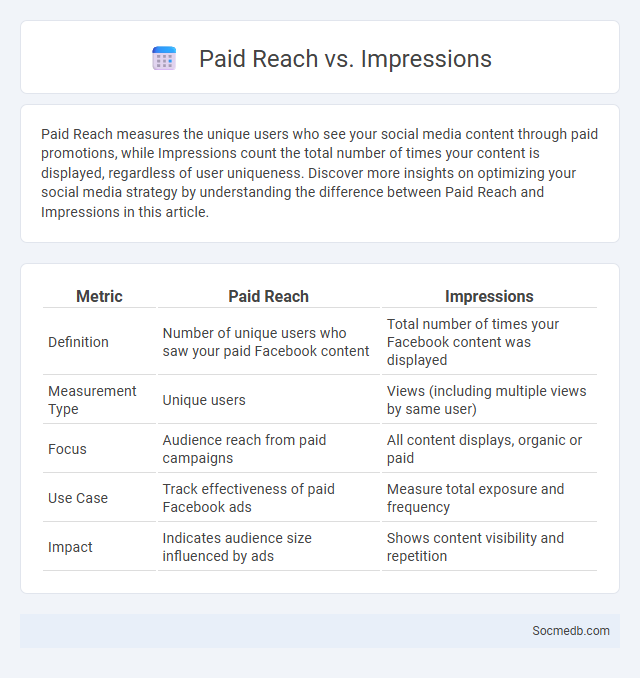
Photo illustration: Paid Reach vs Impressions
Paid Reach measures the unique users who see your social media content through paid promotions, while Impressions count the total number of times your content is displayed, regardless of user uniqueness. Discover more insights on optimizing your social media strategy by understanding the difference between Paid Reach and Impressions in this article.
Table of Comparison
| Metric | Paid Reach | Impressions |
|---|---|---|
| Definition | Number of unique users who saw your paid Facebook content | Total number of times your Facebook content was displayed |
| Measurement Type | Unique users | Views (including multiple views by same user) |
| Focus | Audience reach from paid campaigns | All content displays, organic or paid |
| Use Case | Track effectiveness of paid Facebook ads | Measure total exposure and frequency |
| Impact | Indicates audience size influenced by ads | Shows content visibility and repetition |
Understanding Paid Reach: Definition and Importance
Paid reach on social media refers to the number of people who see your content as a result of paid promotions, such as ads or boosted posts, which extends beyond your organic audience. Understanding paid reach is essential for optimizing advertising budgets and targeting strategies, ensuring your message effectively reaches potential customers who may not be engaged with your usual content. By analyzing paid reach metrics, You can improve campaign performance and maximize return on investment across platforms like Facebook, Instagram, and Twitter.
What Are Impressions? A Comprehensive Overview
Impressions on social media represent the total number of times your content is displayed, regardless of whether it was clicked or not, serving as a key metric for measuring content visibility. This metric helps you understand how often your posts appear on users' screens, which is crucial for assessing brand awareness and the reach of your marketing campaigns. Tracking impressions allows you to optimize your social media strategy by identifying the types of content that generate the highest exposure and audience engagement potential.
Comparing Paid Reach and Impressions: Key Differences
Paid reach refers to the number of unique users who see your social media content through paid promotions, while impressions represent the total number of times your content is displayed, regardless of user uniqueness. Understanding that paid reach targets a specific audience for maximum engagement helps you allocate budget more effectively, whereas impressions measure overall visibility and brand exposure. Maximizing your social media strategy involves balancing these metrics to optimize both audience reach and content frequency.
The Role of Paid Reach in Digital Marketing Campaigns
Paid reach significantly enhances digital marketing campaigns by targeting specific audiences beyond organic limitations, increasing brand visibility and engagement. Platforms like Facebook, Instagram, and LinkedIn offer advanced targeting options, allowing you to optimize ad spend and achieve measurable results. Your investment in paid reach drives higher conversion rates and maximizes return on ad spend through precise audience segmentation and real-time analytics.
How Impressions Influence Ad Performance
Impressions play a crucial role in social media ad performance by measuring how often an ad is displayed to users, directly impacting brand visibility and awareness. High impression counts can increase the likelihood of user engagement, such as clicks and conversions, by repeatedly exposing the target audience to the ad content. Optimizing impressions through targeted audience segmentation and timing enhances overall ad effectiveness and return on investment (ROI).
Metrics That Matter: Paid Reach vs Impressions
Paid reach indicates the number of unique users who see your social media ads, providing a direct measure of audience exposure and campaign effectiveness. Impressions count the total number of times your content is displayed, reflecting overall visibility but potentially including multiple views by the same user. Understanding the distinction between paid reach and impressions helps you optimize ad spend and tailor strategies to maximize Your brand's impact on target audiences.
Optimizing Advertising Strategies Using Paid Reach
Optimizing advertising strategies using paid reach enhances your brand's visibility by targeting specific demographics with precision and maximizing engagement rates. By leveraging data analytics and audience insights, you can fine-tune ad placements and budget allocation to achieve higher conversion rates and reduce wasted spend. Your campaigns will benefit from continuous monitoring and A/B testing, ensuring adaptive improvements and sustained performance growth.
Impressions: Quality vs Quantity Debate
Impressions on social media measure how many times content is displayed, but the debate centers on quality versus quantity. High-quality impressions target relevant audiences, increasing engagement and conversion rates, while sheer volume may inflate numbers without meaningful interaction. Brands prioritizing quality impressions often achieve stronger brand loyalty and more effective marketing outcomes.
Tracking and Analyzing Paid Reach Effectively
Tracking and analyzing paid reach on social media requires integrating tools like Facebook Ads Manager and Google Analytics to monitor impression data, click-through rates, and conversion metrics accurately. Employing UTM parameters enables precise attribution of paid campaigns, improving the granularity of audience behavior insights. Regularly reviewing these analytics facilitates optimizing ad spending and maximizing return on investment (ROI) in targeted social media marketing efforts.
Choosing Between Paid Reach and Impressions for Campaign Success
Choosing between paid reach and impressions plays a critical role in optimizing social media campaign success. Paid reach targets unique users, maximizing audience penetration and engagement, while impressions measure total views, reflecting campaign visibility and brand awareness. Prioritizing paid reach benefits precise audience targeting and conversion rates, whereas impressions drive broad exposure essential for scaling brand recognition.
 socmedb.com
socmedb.com